Subscribe now to get notified about IU Jharkhand journal updates!
The prosperity of Nigerian Manufacturing Companies: Effect of Human Resource Conservation
Abstract :
This study investigates the effect of human resource conservation on the prosperity of manufacturing companies in Nigeria using cross-sectional survey. The accessible population consists of ten functional manufacturing companies in Nigeria using simple random sampling. Eighty -five (85) top level managers and middle level managers were surveyed from ten manufacturing companies. A Sample size of seventy (70) was ascertained using Krejcie and Morgan. Seventy (70) copies were administered, but sixty- two (62) copies of the questionnaire were correctly filled and returned. Simple regression was used to analyse the hypotheses. This study found that human resource conservation has a significant effect on the prosperity of manufacturing companies in Nigeria. This study concluded that human resource conservation that is measured in terms of the good working environment; provision of social security, stable payment of salary, availability of medical care will enhance the prosperity of manufacturing companies in Nigeria. One of the recommendations is that Nigerian government should mandate all manufacturing companies to register with social trust funds where they will be making financial contributions that can be accessed anytime a worker has a serious ailment to deal with.
Keywords :
Organizational prosperity, human resource conservation, social security, good working environment, stable payment of salary.Introduction:-
Manufacturing companies are one of the major
employers of labour in Nigeria through the location of
industries, sourcing of raw materials from the rural
areas for production as well as employment of people
that are ready and qualify to work. The manufacturing
industry in Nigeria has over the years contributed
positively to Nigeria's economic prosperity by
increasing the revenue base of the country. The
prosperity of manufacturing companies is the bedrock
of existence for every small and medium enterprise
(SMEs) in the world. Thus, human resource that
constitutes the operational vehicle cannot be neglected
especially as it concerns their welfare and emotional
needs even as they are faced with digitalization
invaders. Most emerging countries like Singapore,
United Arab Emirates commenced their journey by
harnessing their human resource from different
disciplines in order to contribute to their country
development. Thus, irrespective of the emergence of
artificial intelligence as well as robotic developments,
the human element remains the regulator and
controller of such intelligentials and more to come. The
Friday Edeh Ogbu1
ontological position regarding organisational
prosperity is as a result of environmental dynamism and
insatiable horizon of man. Both existing and emerging
organizations strategic intents focuses more on longterm
goals that will translate to succession transition by
maintaining the culture and philosophies of the
founding member of the firm. Prosperity consciousness
has contributed positively to the survival and
sustainability of manufacturing companies in Nigeria
and other parts of the globe (Sangosanya, 2011).
McShane and Von Glinow (2018) contended that
prosperity gives hope to firms and promotes their
strategic advantage in the business environment. It has
been shown that firms that are prosperous eliminate
stress and emotional sickness from their workplace
(Jones and George, 2017). Robbins and Judge (2018)
added that managers that are prosperity conscious
employ leadership consideration behaviour to influence
their subordinates. Wheelen and Hunger (2012) asserted
that even as the business environment is controlled by
unforeseen circumstance, prosperity still dominates
abstract thinking in decision making.
Nonetheless, corporate prosperity has contributed
positively to the economic development, advancement
and sustainability of emerging countries such as
Nigeria, South Africa, Brazil, Singapore, Malaysia,
United Arab Emirates to mention but a few. The
prosperity of every business is usually ascertained by
its human resource that represents the third
organisational resources excluding financial and
material resources. Organisational prosperity
engineers and stimulates commitment and job
satisfaction of manufacturing company workers in
Nigeria (Umoh, Amah and Wokocha, 2014). The
prosperity of most manufacturing firms has increases
their brand loyalty and enhances their reputation in
most society where they operate. Manufacturing
companies thrive in a stable environment and hence,
their prosperity is the foundation for their existence.
Thus, any organization that does not perceived
prosperity as a necessity is usually characterized with
instability, crises, conflicts and societal disrespects.
Even states and other governmental agencies find it
very difficult to transact business with such firms. This
is evident in the financial sector where before loan is
granted to firms their past records are always
paramount in the acquisition of loans. Such
information is necessary for the financial institutions
who perceived the loan that will be disbursed to the
firm as the investor whose major objective is to make
profit from the investment made.
From the foregoing, any manufacturing company that
want to prosper especially in the midst of internet age;
human resource must be conserved in order to keep the
organization at the maturity stage by dominating the
entire business circumference. Human resource
conservation in this paper refers to the process of
protecting and preserving skillful and talented
employees that will drive organisational objectives. For
instance, for developing countries like Nigeria to make
sustainable progress in the areas of manufacturing,
information and communication technology,
nanotechnology, aeronautic engineering, space
engineering, nuclear engineering, financeology quite
apart from quick and quality service delivery; it must
embrace human resource conservation otherwise its
human capital assets will migrate to other countries
since the comparative advantage of other countries
come from the knowledge of its human resource.
However, upon numerous problems facing Nigeria
today which include unstable power supply,
unsustainable manufacturing of goods and services,
lack of continuity with national plans, insecurity,
inequitable distribution of resources, lack of durable
and accessible roads, lack of human resource utilization
and conservation, to mention but a few, the country has
been moving on a snow ball mechanism compared to
other countries that gained their independence the same
period with Nigeria.
The above maladies were majorly responsible for
human capital flight the manufacturing sector in
Nigeria and this has made some young graduates and
expatriates to develop appetite in search of greener
pasture by travelling along Sahara desert across
Mediterranean Sea with the hope of moving to Europe
where they perceived their talent is needed. Most times,
these young graduates perished in the Mediterranean
Sea without their families' knowledge. Thus, the reason
is that the manufacturing companies in Nigeria as well
as the Nigeria government has not adequately paid
attention to its human capital assets that were valued by
other countries such as United Kingdom, Italy and
United States of America. Even when it is assumed
amongst some nations that there is common wealth,
such wealth is never found on the road rather it is
inherent in the brains of citizens that constitute the
country the individuals happens to find themselves.
This study therefore elucidates that managers and
organisational leaders in manufacturing companies in
Nigeria can preserve and protect their talented
employees through the provision of social security,
good working environment, stable payment of salaries,
and provision of medical health care that is accessibility
and affordable. Since most manufacturing industries in
Nigeria collapsed, government institutions have been
the major employment of labour. Almost seventy five
percent of Nigeria working class citizens are under the
state and federal government wage bills. Even as these
human capitals are doing their jobs diligently,
sometimes they receive half salaries and in some
occasion they are not even paid. This menace has made
some them to commit suicide since they cannot cope
with the situation any longer.
From the foregoing praxisiology, imaginations are some
of the pictorial evidence that brings to mind the
prosperity of multinationals such as Toyota, LG, Nissan,
Ford Motors, Suzuki, Samsung, Innoson, Dangote
Group, Shell petroleum quite apart from other brands
like Adidas, Kodak, Emirate Airlines, South West
Airlines to mention but a few that had been in operation
since they were founded. The question that one needs to
ask is that; what has contributed to the above named
organizations prosperity? The answer is human
resource conservation (HRC). The governments where
these multinationals were founded made it possible for
a stable economy that takes good care of its citizens
without leaving the citizens to start thinking of what to
eat? Or what does tomorrow holds? Suffice to argue that
successive Nigeria government has not conquered
Maslow's physiological needs compared to other
countries. Take for instance; Nigeria is a country where
citizens carry with them bags of rice, yam, and other
foodstuff when travelling to their hometown and when
returning to urban centres while other countries, the
case is different. This has made Nigeria's workers in
various sectors of the economy to engage themselves in
all sorts of menial jobs added to psychological contract
they signed with the government. The absence of good
working environment, social security, stable payment
of salaries and availability of medicare has made
Nigerian human resource to be unproductive whereas
in other countries they are celebrated as knowledge
banks. It is against this backdrop that this study
investigates the effect of human resource conservation
on the prosperity of manufacturing companies in
Nigeria.
Review Of Literature
Human Resource Conservation (HRC)
Human resource management scholars across the globe have not literally reviewed nor dissected human resource conservation (HRC) as no one has developed or investigated the phenomena. In order to increase the knowledge gap that exist, the author deem it necessary to contribute to Human resource management as well as management discipline the concept of human resource conservation. Human resource conservation may not have been trending in the fields of management or social sciences research but just like every other variable that has dominated empirical household the researchers has made it available for other scholars to unravel the mirage behind it and use it for decision making as well as to help organizations preserve the potentiality of human resource in their domain. Drawing from the word “human resource”; which refers to people, human capital “conservation”, was added to mean the process of preserving, keeping, guarding skillful employees for the purpose of meeting the objectives of the organization in the present and future. In another binoculars, it can be viewed as the ways in which managers use to keep and protect their employees from leaving the organization for future utilization. Several countries preserve its human resource through the provision of good amenities, social security and so forth. The reason why most talented Nigerian youths travelled through Sahara desert in search of opportunities is as a result of poor state of the economy where resources were held in the hands of the few. Take for instance, after a four years university education in Nigeria one is expected to be engaged by the government or private enterprise but the picture is not real in Nigeria. This has resulted to high rate of unemployment.
Indicators of Human Resource Conservation
This study is of the view that in order to conserve human resource in Nigeria, certain indicators that will that possible are provisions of social security, good working environment, stable salary payment, and availability of medical health care as reviewed in the preceding sections.
Provision of Social security:
In this paper, social security refers to any government designed system that provides monetary assistance to citizens no income (David, 2003). Social security may also refer to the action programs of an organization intended to promote the welfare of the population through assistance measures guaranteeing access to sufficient resources for food and shelter and to promote health and well-being for the population at large and potentially vulnerable segments such as children, the elderly, the sick and the unemployed (Wikipedia. org, 2018). Social security had been in existence in the United States of America since its introduction in 1935. Social security in the U.S covers retirements, disability benefits, survivors' benefits, supplementary security income and medicare. In addition, Vrooman (2009) stressed that social security is not limited to provision of cash transfers, but also aims at security of work, health, and social participation; and new social risks (single parenthood, the reconciliation of work and family life) should be included in the list as well.
Good working environment:
The environment in which work is carried out is known as working environment. However, work deserves a conducive and healthy environment to ease accessibility stress and other inhibitors of work. Good working environment refers to interior and exterior physical environment where employees carry out their obligations for the benefit of the organization. For those working in the oil and gas industry for instance, provision of safety wears are paramount as well as socialization on safety policies. Service oriented firms may require good office space with the required facilities such as office chairs, tables, air conditions, electric fans, computers and other paraphernalia needed in an idle office. In some manufacturing companies, some employees do not have safety materials to support their daily activities; hence they become exposed to workplace accident that may claim their lives. Where they can perform their jobs effectively. Federal ministry of environment and other government agencies has not also done well because; most manufacturing companies that does not comply with their guidelines should have been prosecuted.
Stable payment of salaries:
Organisations that pay salaries promptly will be stable because the employees are always happy since their salaries are paid as at when due. With money in the hands of the employees, their personal plans will be achieved but if they are paid for one month in the third month, their morale will decrease and the passion for the job will drop drastically. In Nigeria for instance, some employees of manufacturing companies received their monthly salaries in a piece meal. Some companies owed their employees two to eight months salaries. Even when they are doing very well in terms of financial buoyancy, the gladiators and founders prefer using the money generated to pursue political goals. In this type of work settings, employees will not be satisfied with their jobs and this has resulted to some workers staying at home because they have spent the little money in their disposal for transport fare and family needs.
Availability of Medical health care:
Medical health care is one factor that can boost organisational stability in the sense that; when employees require medical treatment and if they can easily access it, they will be committed to their organization and their nation. But if there is no accessible and affordable medical health care, especially in a situation where an employee have not been paid for two months, he/she cannot even approach private hospital for medical health care because there is no money to pay for the services in the private medical health care providers. If the president of Nigeria will travel as far to United Kingdom just for medicare, what hope do the citizens have? Healthcare is one of the manifestos for elections in some countries but roads are manifestos for political campaigns in Nigeria.
Organisational Prosperity
Organisational prosperity has not been reviewed
extensively compared to other organisational variables
such as organisational commitment (Akpan, 2013; Allen
and Meyer, 1996; Agba, Nkpoyen and Ushie, 2010);
organisational justice (Cropanzano, Bowen and
Gilliland, 2007; Owolabi, 2012; Najaf, Keivan and
Shahnaz, 2012; Lambert, 2003; Colquitt, Conlon,
Wesson, Porter and Ng, 2001); organisational
performance (Richard, Devinney, Yip and Johnson,
2009; Dialoke and Duru, 2017); organisational
effectiveness (Olagunju, 2010; Manzoor, 2012; Agu and
Anichebe, 2015); organisational sustainability
(Mohrman and Worley, 2010; Judita, Noel and Vlado,
2015; Eketu and Edeh, 2017); organisational culture
(Shakil, 2012; Lok and Crawford, 2004; Sharma, 2017);
organisatioanl citizenship behaviour (Organ, 1988;
Obamiro, Ogunnaike and Osibanjo, 2014; Ehtiyar, Alan
and Ömüriº, 2010) to mentioned but a few. The word
'prosperity' refers to a state of thriving and flourishing.
When 'organisational' is added to it; it becomes
organisational prosperity which is the state of
flourishing or thriving in the business world. This
definition was drawn from the perception that
organization that is doing well consistently has the
capacity to thrive amongst rivalries. Chew (2005) asserts
that organsiational prosperity is a new measure of
ascertaining how well corporate entities are doing in the
industry. The prosperity of businesses in Nigeria is
dependent on the nation's prosperity which implies
that; when the government is flourishing, the firms in
that country ought to be prospering.
Nevertheless, the prosperity of Nigeria is associated
with its human capital; hence its conservation is very
essential for the sustainability of the country's
industries. It is against this premise that federal
government of Nigeria came up with different
motivational policies such as new minimum wage that is
aimed at boosting workers moral and giving them an
opportunity to contribute their quota in national
development. The current minimum wage corresponds
with Nigeria's quest for salary and other emoluments
that will engender workers performance. Meanwhile, if
the workers who make up the public service (human
resource) are well conserved through the provision of
social security, provision of good working environment,
stable payment of salaries, and provision of medical
care, Nigerian public organisations will prosper in every
endeavour. For instance, an international firm such as
South West Airlines has been known as flourishing
organization due to how its founding members handled
their first crises that would have sent the enterprise
packing. Other firms like Microsoft Corporations, Ford,
Barclays Bank, Hewlett Packard, ExxonMobil, to
mention but a few have been known as firms that are
prospering. The point here is that without the above
mention indicators it will be very difficult to conserve
the employees of these firms to have remained without
leaving to another organisation. Also, if the employees
are not conserved, the above firms would not have been
in existence to date.
The Nigerian work environment is totally different from
developed nations like United States of America, United
Kingdom, Germany, South Korea, Canada, France and
so forth where social security is active and employees in
the above mentioned countries are not thinking about
what they will eat, what will happens to them when they
are laid off? Where they will lived? On the other hand,
the Nigerian worker is constantly thinking about the
above questions. This has made human resource
conservation very difficult in Nigeria. Salaries in most of
manufacturing companies as well as some government
owned institutions owed their workers to the extent that
some of the workers have to be evicted from their rented
apartments by their house owners because of the rent
they could not pay which is as a result of non-payment
of their monthly salary. In some instance, if at all salaries
are paid, some manufacturing companies will owe
workers for about five months to one year before paying
them for one month or two while the remaining seven or
nine months will be pending. This malady is what has
caused many young people to lose hope in the industry
and resorted to embarking on journey to Europe
through Libya which of course has led many to death.
In furtherance, good working environment creates
good atmosphere for employees to increase their efforts
without supervision. Most Nigerian manufacturing
sector is usually characterized with poor working
environment with exception of few ones that adhered to
Nigerian labour laws on working environment. The
story is quite different especially in local manufacturing
industries owned and managed by indigenous
managers where an employed manager has no office to
carryout his/her duties effectively rather; he/she
makes use of what is readily available. How will such
employee be effective or motivated to work? This is
what the manufacturing companies in Nigeria must
address if productivity is to be promoted and patriotism
embraced otherwise its human resource will prefer
going to other countries for greener pastures where
such amenities or facilities are readily made available to
citizens. Based on the above, a conceptual framework
that will guide this study has been drawn as shown
below.
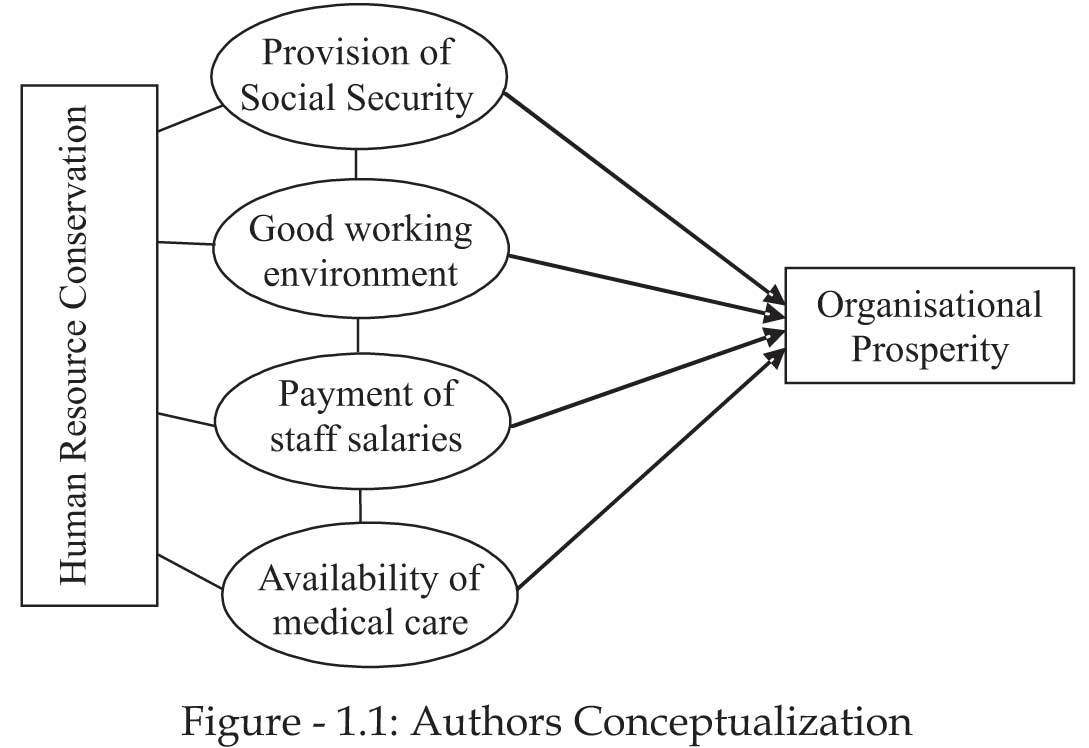
The model above shows how human resource
conservation in Nigeria will enhance the prosperity of
its organizations through the effective implementation
of accessible social security, good working
environment, and stable payment of monthly salaries
and availability of medical health care to workers. Thus,
when Nigerian manufacturing firms' flourishes, the
economy will no longer be dependent on government
for job creation but will triumph to entrepreneurial
driven society. Based on the framework in figure 1.1, the
following alternate hypotheses were formulated.
HA1: provision of social security has positive significant
effect on organisational prosperity of manufacturing
companies in Nigeria
HA2: good working environment has positive significant
effect on organisational of manufacturing companies
in Nigeria
HA3: stable payment of salary has positive significant effect
on organisational of manufacturing companies in
Nigeria
HA4: availability of medical care has positive significant
effect on organisational of manufacturing companies
in Nigeria
Theoretical Underpinning
This study is anchored on social exchange theory (Blau, 1964) and human capital theory (Bontis, Dragonetti, Jacobsen and Roos, 1999). Social exchange theory holds that human behaviour and social interaction is basically an exchange of both intangible and intangible activities (Homans, 1961). Ahiauzu and Asawo (2016) added that social exchange theory employees in the workplace engage in a self-interested exchange process with their employers and among themselves and strive to maximize the benefits of such an exchange process. This implies that, employees in the manufacturing companies are in exchange with their employers in terms of their knowledge, skills, and abilities for pay at the end of the month. On the other hand, human capital theory holds that people who are employed in the workplace possessed skills, abilities and knowledge that must be valued by their employer which will encourage their performance (Armstrong, 2009).
Methodology
Research design:
Cross-sectional survey was adopted in this study as it involves the use of questionnaire to collect data at one point (Sekaran and Bougie, 2016).
Population of the study:
Target population comprises of functional manufacturing companies operating in Rivers state, Nigeria. On the other hand, the accessible population comprises of ten functional manufacturing companies in Port Harcourt City of Rivers State in Nigeria. Thus, the researchers surveyed eighty five (85) top level managers and middle level managers from the ten manufacturing companies.
Sampling technique/sample size determination:
Simple random sampling was used to survey ten manufacturing companies in Port Harcourt, Rivers State from Manufacturers Association of Nigeria (http://phmanufacturersnigeria.org/members.html). Sample size of seventy (70) was determined using Krejcie and Morgan (1970).
Method of data collection:
Primary data (questionnaire) was used to elicit responses from the top level and middle level managers. However, the researchers administered seventy (70) copies of questionnaire to the managers. Out of these copies, sixty two (62) copies of questionnaire were correctly field and used for data analysis.
Instrumentation:
Validity of instrument was determined using face validity while cronbach alpha was used to ascertain the reliability of the instrument. The cronbach alpha values of human resource conservations fall within the benchmark of .70-.80 which is acceptable as a rule of thumb in management sciences (Saunders, Lewis and Thornhill, 2009; Bryman and Bell, 2007).
Measurement of variables:
Indicators of direct compensation were measured with four items on five point Likert scales (5 (Strongly agree); 4(Agree); 3(Disagree); 2(Strongly disagree) and 1(Neither agree nor disagree).
Data analysis technique:
Respondents' demographic characteristics were analysed using frequency distribution while simple regression was employed to analysed the hypotheses with the aid of statistical package for social sciences (20.0).
Results
Respondent's Demographic Characteristics

Table - 1.1 above shows the gender of sixty two (62) respondents from ten manufacturing companies in Port Harcourt, Nigeria. 39 respondent representing 62.9% were males while 23 respondents representing 37.1% were females. This implies that males dominate manufacturing companies under study.

The table above shows the number of years in service of sixty two (62) respondents from ten manufacturing companies in Port Harcourt, Nigeria. 20 respondents representing 32.3% have served their company between 8-15 years; 28 respondents representing 45.2% have served their company between 16 years and above; while 14 respondents representing 22.6% have served their company between 1-6 years. This means that most of the respondents have worked with their respective manufacturing companies between 8-15 years and 16 years and above.

Table - 1.3 above shows the academic qualifications of sixty two (62) respondents from ten manufacturing companies in Port Harcourt city in Nigeria. 9 respondents representing 14.5% have attended secondary school; 5 respondents representing 8.1% have attended basic primary school; 7 respondents representing 11.3% hold PhD degrees; 11 respondents representing 17.7% hold master degrees; 30 respondents representing 48.4% hold bachelor degrees. This implies that majority of the respondents have attained university education which shows that they are literate.
Analyses of Hypotheses
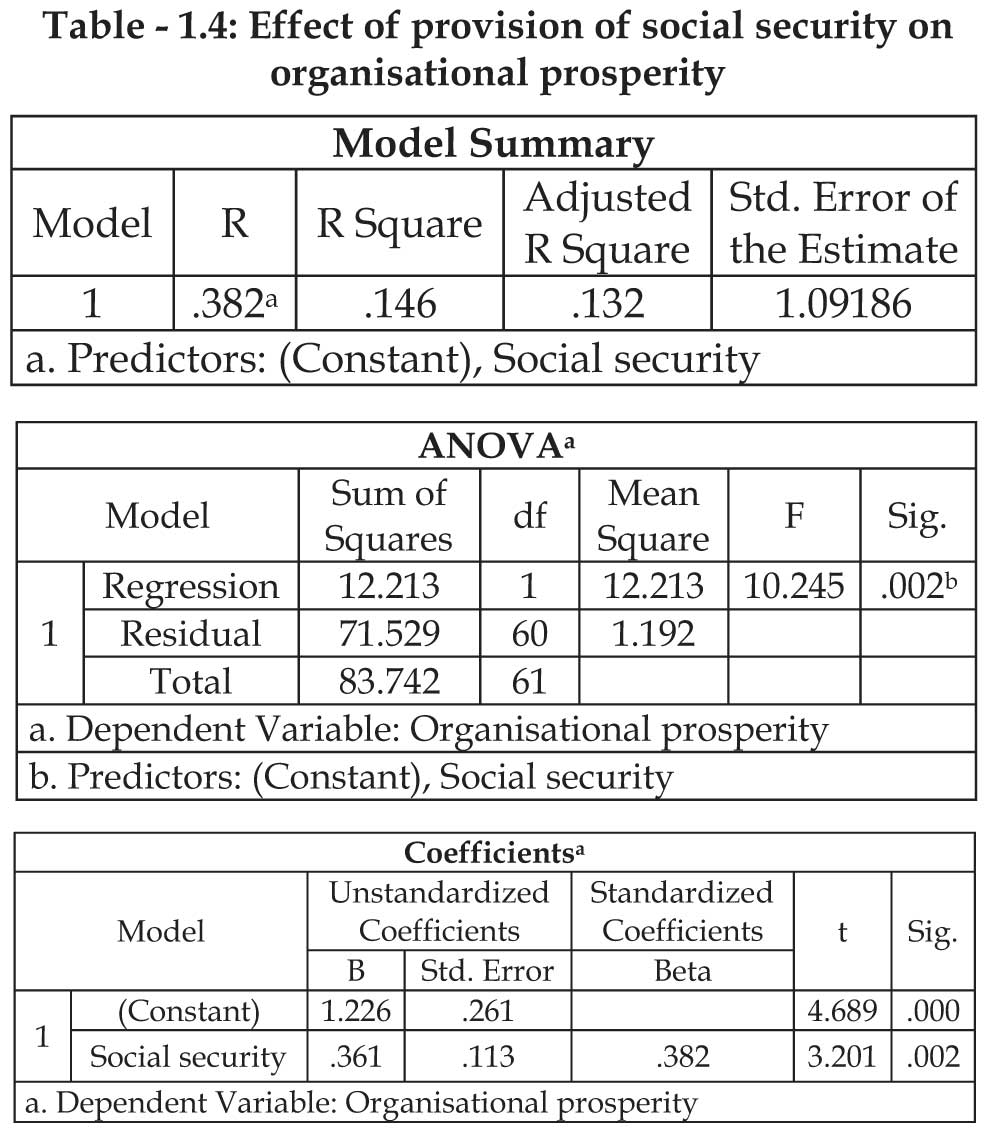
The above result in table 1.4 shows the linear regression analysis between provision of social security and organisational prosperity. The F-ratio in the ANOVA reavled that the independent variable is significant and predicted the dependent variable, F (1,60) = 4.00, p<0.05, R2 =.146 and with a high moderate degree of effect (R=.382a). The result indicates that provision of social security has positive significant effect on organisational prosperity (.002<0.05). Thus, the calculated (10.245) > tabulated (4.00), which implies that the alternate hypothesis is accepted.
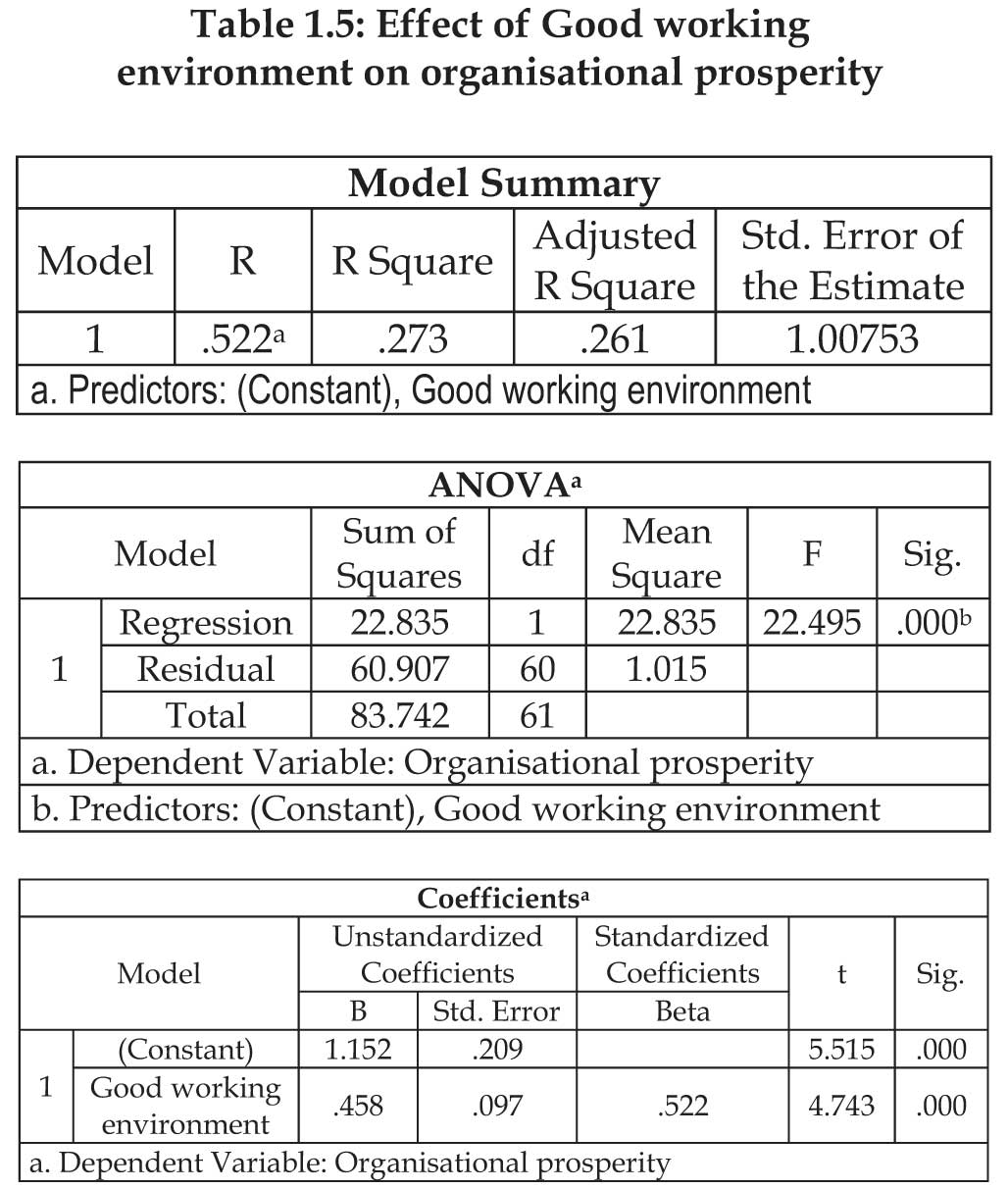
Table-1.5 results show the linear regression analysis be twe en good working envi ronment and organisational prosperity. The F-ratio in the ANOVA table revealed that the independent variable (good working environment) is significant and predicted the dependent variable (organisational prosperity), F (1,60) = 4.00, p<0.05, R2 =.273 and with a high degree of effect (R=.522a). The result show that good working environment has positive significant effect on organisational prosperity (.000<0.05). Thus, the calculated (22.495) > tabulated (4.00), which means that the alternate hypothesis is accepted.
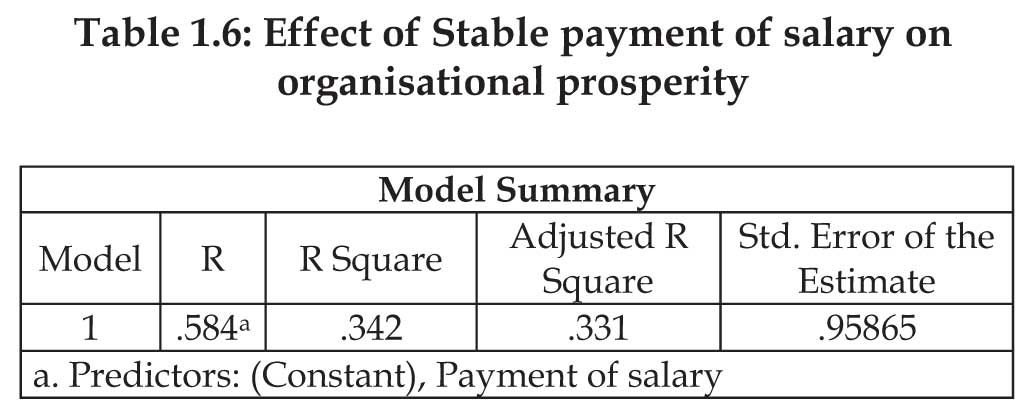
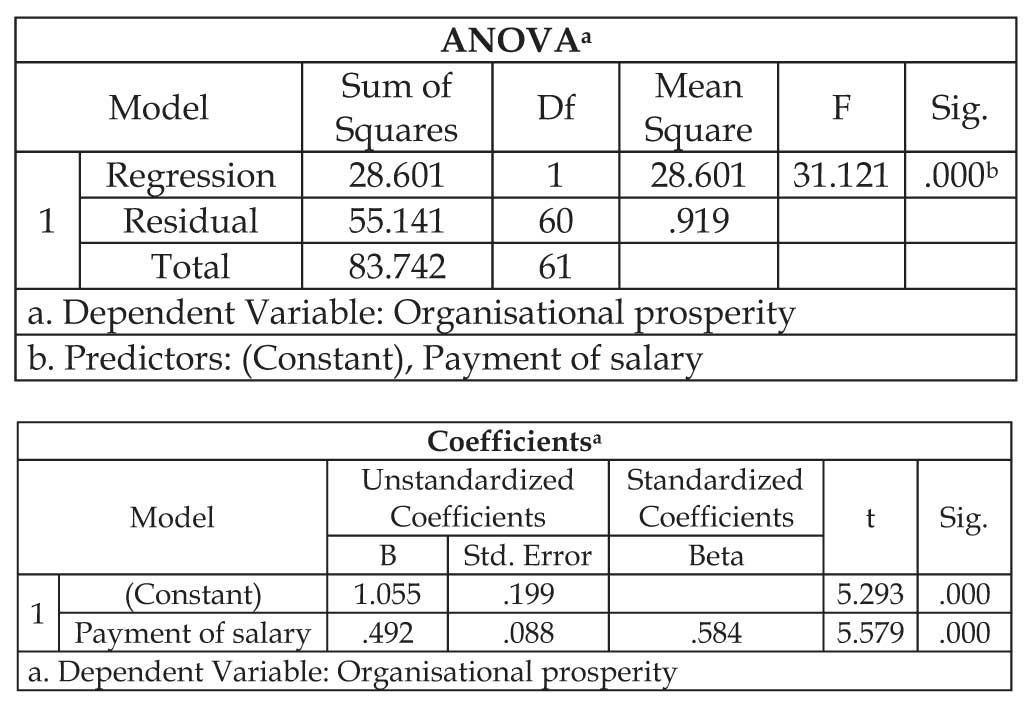
Table -1.6 results above show the linear regression analysis between payment of salary and organisational prosperity. The F-ratio in the ANOVA table show that the independent variable (payment of salary) is significant and predicted the dependent variable (organisational prosperity), F(1,60) = 4.00, p<0.05, R2 =.342 and with a high degree of effect (R=.584a). The result show that payment of salary has positive significant effect on organisational prosperity (.000<0.05). Thus, the calculated (31.121) > tabulated (4.00), which means that the alternate hypothesis is accepted.
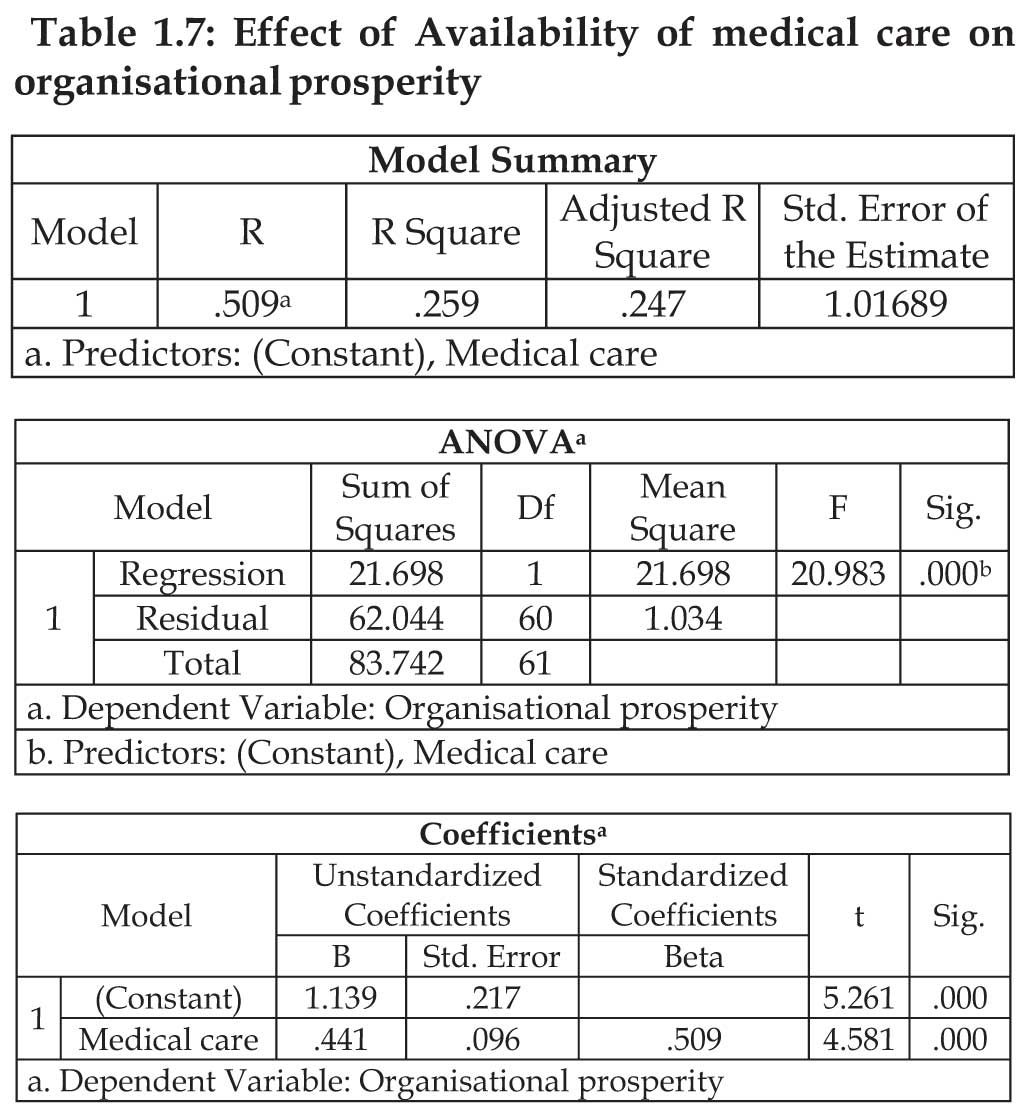
Table-1.7 above shows the linear regression analysis between availability of medical care and organisational prosperity. The F-ratio in the ANOVA table revealed that the independent variable (availability of medical care) is significant and predicted the dependent variable (organisational prosperity), F(1,60) = 4.00, p<0.05, R2 =.259 and with a high degree of effect (R=.509a). The result show that availability of medical care has positive significant effect on organisational prosperity (.000<0.05). Thus, the calculated (31.121) > tabulated (4.00), which means that the alternate hypothesis is accepted.
Discussion
Based on the hypotheses results above, this study found that human resource conservation measured in terms of payment of salary, availability of medical care, provision of good working environment and provision of social security has significant effect on the prosperity of manufacturing companies in Nigeria. Prompt payment of monthly salary to workers is what motivates them to exert performance which contributes to the profitability of the companies. Another way to conserve human resource in the manufacturing companies is the provision of available medical care in the case of injury or accident during work or outside the workplace. The finding also indicates that access to social security can engender the prosperity of manufacturing companies in Nigeria especially when manufacturing companies are contributing into the social trust fund which can be accessed whenever a worker requires urgent medical attention.
Conclusion and recommendations
This research concludes that human resource conservation that is measured in terms of good working environment; provision of social security, stable payment of salary, availability of medical care will enhance the prosperity of manufacturing companies in Nigeria. Based on the conclusion, the following recommendations were made.
- Nigerian government should as a matter of urgency mandate all manufacturing companies to register with social trust fund where they will be making financial contributions that can be accessed anytime a worker has serious ailment to deal with.
- Nigerian National Assembly should enact a law that will put an end to delay or non-payment of salaries by manufacturing companies in Nigeria.
- Federal Ministry of Environment should supervise the work environment of manufacturing companies in Nigeria monthly to enable them keep to international acceptable standards.
References:
- Agba, A.M.O, Nkpoyen, F.& Ushie, E.M. (2010). Career development and employee commitment in industrial organisations in Calabar, Nigeria. American Journal of Scientific and Industrial Research, 1(2), 105-114.
- Agu, O.A. & Anichebe, N.A. (2015). Improving organisational effectiveness in Nigeria public enterprise. International Journal of Development Research, 5(06), 4811-4818.
- Ahiauzu, I.A. & Asawo, P.S. (2016). Advanced social research methods. Port Harcourt: CIMRAT Publications.
- Akpan, C.P. (2013). Job security and job satisfaction as determinants of organizational commitment among university teachers in cross river state, Nigeria. British Journal of Education, 1(2), 82-93.
- Allen, N.J. & Meyer, J.P. (1996). Affective, continuance, and normative commitment to the organization. Journal of Vocational Behaviour, 49, 252–276.
- Armstrong, M. (2009). Armstrong's handbook of human resource management practice. (11th edn.). London: Kogan Page.
- Blau, P. (1964). Exchange and power in social life. New York: Wiley.
- Bontis, N., Dragonetti, N.C., Jacobsen, K. & Roos, G. (1999). The knowledge toolbox: A review of the tools available to measure and manage intangible resources. European Management Journal, 17(4), 391- 402.
- Bryman, A. & Bell, E. (2007). Business Research Methods. (2nd edn.). New York: Oxford University Press.
- Chew, Y.T. (2005). Achieving organisational prosperity through employee motivation and retention: A comparative study of strategic HRM practices in Malaysian institutions. Research and Practice in Human Resource Management, 13(2), 87-104.
- Colquitt, J.A., Conlon, D.E., Wesson, M.J., Porter, C.O.L.H. & Ng, K.Y. (2001). Justice at the millennium: A meta-analytic review of 25 years of organizational justice research. Journal of Applied Psychology, 86, 425– 445.
- Cropanzano, R., Bowen, D.E. & Gilliland, S.W. (2007). The management of organizational justice. Academy of Management Perspectives, 34-48.
- David, B. (9 October 2003). 1001 Financial Words You Need to Know. Oxford University Press, USA. 185.
- Dialoke, I. & Duru, I.M. (2017). Effects of workforce planning on organizational performance a study of selected media houses in Imo state. International Journal of Social Sciences and Management Research, 3(2), 1-7.
- Ehtiyar, V.R., Alan, A.A. & Ömüriº, E. (2010). The role of organizational citizenship behavior on university student's academic success. Tourism and Hospitality Management, 16(1), 47-61.
- Eketu, C.A. & Edeh, F.O. (2017). Human resource planning and organisational sustainability. A study of selected telecommunication firms in Rivers State. International Journal of Social Sciences and Management Research, 3(3),37-46.
- Homans, G.C. (1961). Social behavior: Its elementary process. New York: Harcourt, Brace & Wood. Jones, G.R. & George, J.M. (2017). Essentials of contemporary management. (7th edn.). New York: McGraw-Hill Education.
- Judita, P., Noel, J.P. & Vlado, D. (2015). Strategic decision making for organizational sustainability: The implications of servant leadership and sustainable leadership approaches. Economic and Business Review, 17(3),273-290.
- Krejcie, R.V. & Morgan, D.W. (1970). Determining sample size for research activities Educational and Psychological Measurement, 30, 607-610.
- Lambert, E. (2003). Justice in corrections: An exploratory study of the impact of organisational justice on correctional staff. Journal of Criminal Justice, 31(2), 155-168.
- Lok, P. & Crawford, J. (2004). The effect of organizational culture and leadership style on job satisfaction and organizational commitment: A crossnational comparison. Journal of Management Development, 23(4), 321–338.
- Manufacturers Association of Nigeria (2019). List of Manufacturers in Nigeria. Retrieved from http://phmanufacturersnigeria.org/members.html
- Manzoor, Q. (2012). Impact of employees motivation on organizational effectiveness. European Journal of Business and Management, 3(3), 36-44
- McShane, S.L. & Von Glinow, M.A. (2018). Organizational behavior. Emerging knowledge. Global reality. (8th edn.). New York: McGraw-Hill Education.
- Mohrman, S. A. & Worley, C.G. (2010). The organizational sustainability journey: Introduction to the special issue. Organizational Dynamics, 39(4), 289–294.
- Najaf, A., Keivan, M. & Shahnaz, S. (2012). Relationship between organizational justice and intention to leave in employees of sport and youth head office of Tehran. European Journal of Experimental Biology,2(5),1564-1570.
- Obamiro, J.K., Ogunnaike, O.O., & Osibanjo, O. (2014). organizational citizenship behaviour, hospital corporate image and performance. Journal of Competitiveness, 6(1), 36 – 49
- Olagunju. L.A. (2010). Occupational stress assessment and organizational effectiveness. Journal of Applied Psychology, 17(2), 110-122.
- Organ, D. W. (1988). Organizational citizenship behavior: The good soldier syndrome. Lexington, MA: Lexington Books.
- Owolabi, A.B. (2012). Effect of organizational justice and organizational environment on turn-over intention of health workers in Ekiti State, Nigeria. Research in World Economy, 3(1), 28-34.
- Richard, P.J., Devinney, T.M., Yip, G.S. & Johnson, G. (2009). Measuring organizational performance: Towards methodological best practice. Journal of Management, 35(3), 718-804.
- Robbins, S.P. & Judge, T.A. (2018). Essentials of organizational behavior. Global Edition. England: Pearson Education Limited.
- Sangosanya, A.O. (2011). Firms growth dynamics in Nigeria's manufacturing industry: A panel analysis. Journal of Applied Econometric Review, 1(1),1-18.
- Saunders, M., Lewis, P. & Thornhill, A. (2009). Research methods for business students. (5th edn.). England: Pearson Education Limited.
- Sekaran, U. & Bougie, R. (2016). Research methods for business: A skill-building approach (7th edn.). United Kingdom: John Wiley & Sons Ltd.
- Shakil, A.M. (2012). Impact of organizational culture on performance management practices in Pakistan. Business Intelligence Journal, 5(1), 50-55
- Sharma, P. (2017). Organizational culture as a predictor of job satisfaction: The role of age and gender. Management, 22(1), 35-48.
- Umoh, G.I. Amah, E. & Wokocha, H. I. (2014). Management development and organizational resilience. A case study of some selected manufacturing firms in Rivers state, Nigeria Journal of Business and Management, 16(2), 07-16.
- Vrooman, J.C. (2009). Rules of relief; institutions of social security, and their impact. Transaction Publishers (The Netherlands Institute for Social Research). 111–126.
- Wheelen, T.L. & Hunger, J.D. (2012). Strategic management and business policy. Toward Global Sustainability, (13th edn.). US: Pearson Education, Inc.
- Wikipedia.org (2018). Social security. Retrieved from https://en.wikipedia.org/wiki/Social_security.
